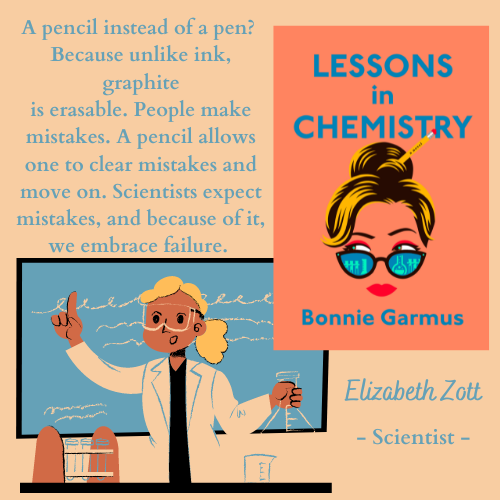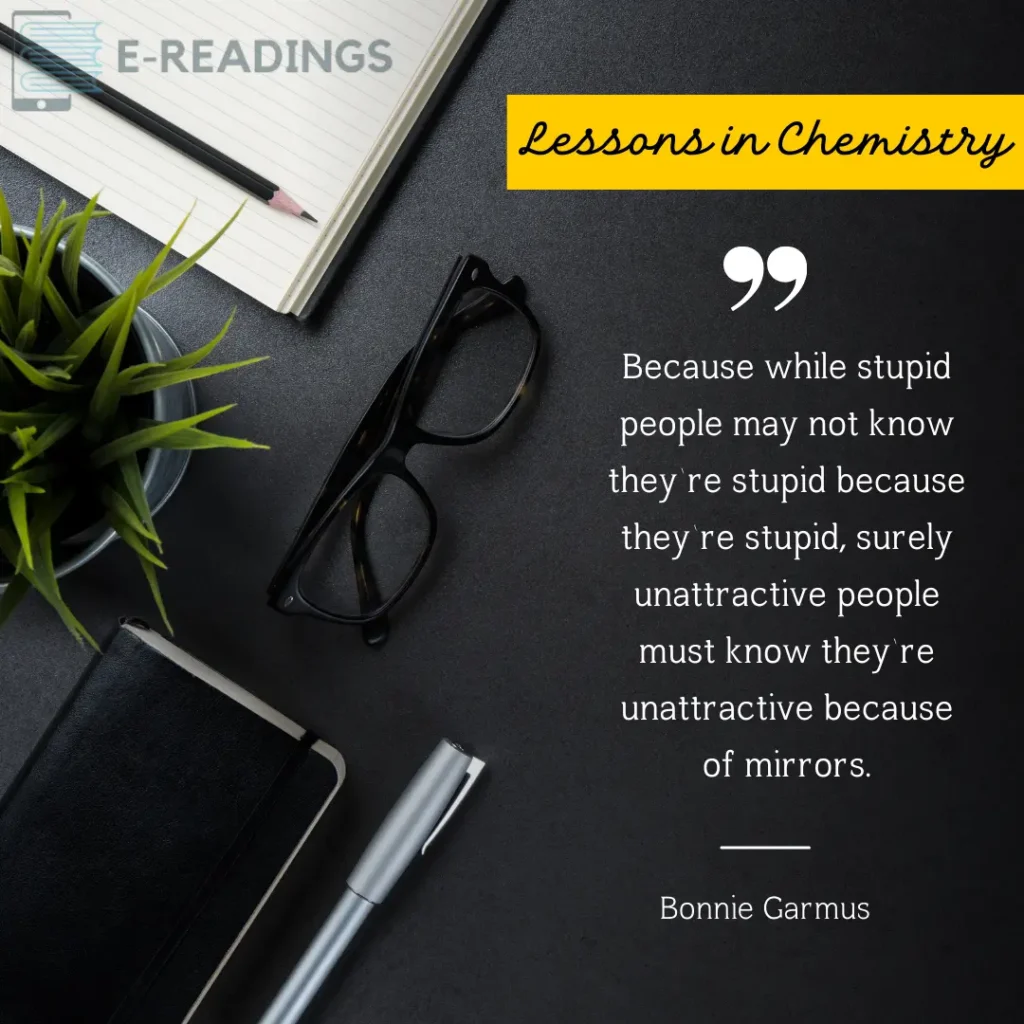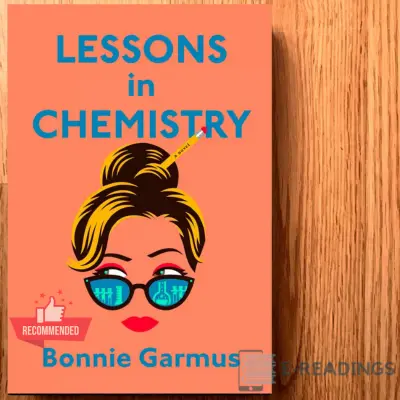Reading through “Lessons in Chemistry” by Bonnie Garmus, I am enthralled with the author’s ability to unravel the complexities not only of molecules but also of the soul during the sixties when Elizabeth Zott defied conventional expectations using her scientific prowess. Unlike this, though, Garmus’ blends of knowledge and emotion result in an authentic melody, which is so fascinating that it turns the world of chemistry into a must-see thing. You can also read the review of It Ends with US by Colleen Hoovers.
Lessons in Chemistry Review:
Bonnie Garmus’ “Lessons in Chemistry” was published on April 5, 2022 and the book combines the magic of storytelling artfully with the science and emotional experiences of humans. This is one of the most ANTICIPATED BOOKS OF THE YEAR. As a reader myself, I was engulfed by the complex choreography of molecular formations and that of Elizabeth Zott’s voyage. Despite being set in the 1960s, Garmus effortlessly maneuvers through the male-dominated scientific atmosphere to produce a composition that appeals to the cerebral as well as emotional sides. The prose serves as proof of the author’s mastery of language and his ability to present complicated scientific principles interestingly. “Lessons in Chemistry” is a literary masterpiece combining knowledge, storytelling, and the eternal search for learning about the world and humanity. This book won GOODREADS CHOICE AWARD WINNER. The New York Times, Washington Post, NPR, Elle, Oprah Daily, Newsweek, GoodReads, Bookpage, Kirkus.

Summary of Lessons in Chemistry:
“Lessons in Chemistry” by Bonnie Garmus is fiction that delves into chemistry as it intertwines with storytelling, which was released last year on March 29th. The story takes place in 1960, when Elizabeth Zott is an astute chemist against social standards. In this case, Garmus superbly examines issues of resilience, gender relations, and delicacy between professional and private affairs. These people are driven by the persistent Elizabeth, who represents the changing mindsets in society. The novel goes beyond literary fame and discusses issues of gender equality in STEM. Therefore, ‘Lessons in Chemistry’ does not only mean a ‘Chemistry Lesson,’ but also a deep reflection on human existence.
| Publisher | Doubleday |
| Publication date | April 5, 2022 |
| Language | English |
| ISBN-10 | 038554734X |
| ISBN-13 | 978-0385547345 |
| Pages | 390 |
Plot:
In that regard, following the storyline of “Chemistry Lessons” by Sara Shepard, Elizabeth Zott was depicted as an amazing scientist working under tough circumstances in her time. This plot focuses on Elizabeth’s drive for scientific recognition while encountering sexism and social constraints. Her unusual way of navigating takes a bold turn and sees her hosting a TV cookery show that articulates complicated scientific theories more simply for a larger audience.
Theme:
In “Lessons in Chemistry,” by Bonnie Garmus, this theme involves interactions between one’s personal and professional endeavors, with particular emphasis on how such issues relate to gender roles or social norms. Elizabeth Zott is a scientist who lived between the 1940s and 1960s, and through her, the challenges that females had at that time in pursuing professions related to science are examined.
Resilience and Perseverance:
The book centers on one major theme – the strength that allows people to follow their dreams despite social expectations and female prejudices. Elizabeth’s tireless quest for scientific validation and her capacity to overcome difficulties epitomize the broader motif of surmounting hurdles.
Gender Dynamics in Science:
The novel explores the sexism that existed within the scientific society of the 1960s. Their fight for recognition in a man’s world becomes evident as one reads through this biography.
Balancing Personal and Professional Life:
“Lessons of Chemistry” examines how an individual’s personal and career goals must be carefully negotiated with one another. This is why Elizabeth’s journey becomes a tool for consideration of obstacles people, especially women, had to overcome to reconcile their ambitions and personal goals with societal norms in the workplace.
Evolution and Change:
It is set in the context of the 1960s and thus portrays some important social developments that took place then. This is just one facet of understanding the social changes of the transformative period concerning gender relations in and out of science.
The Indomitable Human Spirit:
The central idea of the novel is about the unbreakable human spirit: to go against tradition, tear down barriers, and live on your terms. Elizabeth’s character represents the toughness necessary to chart one’s territory and leave an imprint where fields of resistance exist.
The book “Lessons in Chemistry” has intertwined and brought together those subjects of life beyond science that are part of its larger society and environment. The novel transforms itself from a mere study of chemistry into an intricate examination of being as one tackles society’s adversities.
Characters in “Lessons in Chemistry”:
Elizabeth Zott: The Protagonist
He was a bright chemist who had to make his way through the thicket of the world science of the sixties. Ventures into an unprecedented trek presents a televised cooking show to disseminate difficult chemical ideas to ordinary people. A fight against prevailing social customs and gender stereotypes turns into an emblem of strength despite suffering.
Supporting Characters: A Rich Ensemble:
- Henry: A colleague of hers who also serves as a friend supports and encourages her towards scientific quests.
- Margaret: A friend who is also Elizabeth’s and offered another point of view and support to her away from the laboratory.
- Romantic Interests: These additional storylines showcase characters that were instrumental in Elizabeth’s life thus making more complex in the story.
Relationships in “Lessons in Chemistry Book”:
Professional Dynamics:
The relationship between Elizabeth and individuals like Henry indicates the hurdles facing the female fraternity in a male world. The lab becomes an enlarged image of the 60’s societal prejudices towards women engaged in scientific work.
Personal Relationships:
- Friendship with Margaret: The relationship between Margaret and Elizabeth becomes an avenue away from the corporate environment, where they both obtain comfort from each other as well as share experiences.
- Romantic Relationships: Elizabeth’s romantic entrapments are explored in the novel, depicting the fine line between individual and career ambitions.
Television Show Dynamics:
Science becomes more reachable by general people through a very special bond established through Elizabeth’s TV show. This adds depth to exploring Elizabeth’s personality, as it illustrates the effect of an unusual approach on her life and career.
Interconnected Lives:
The plot of “Lessons in Chemistry” develops around the numerous relationships between its characters, which ultimately enhances the story. The examination of gender relations, normative ideologies about identity and society, and wider human life leads each of these characters to participate in a richly affecting and complex trip.
Highlight the importance of chemistry in everyday life:
The lessons in chemistry presented in Bonnie’s Lessons in Chemistry demonstrate the chemical nature that surrounds us on a daily basis. It is the science that infiltrates daily life in its most simple and complicated aspects, becoming part of the tapestry of daily routine. Thus, even in cooking chemistry’s role is tangible as it involves the transformation of ingredients and formulation of household products geared towards improving quality of life. The case of Garmus, who portrays for us how science makes even ordinary things fascinating, is how this happens. In this regard, the novel becomes a powerful lesson in support of the fact that chemistry does not belong to science only. It is part and parcel of everyday life. “Lessons in Chemistry” is an engaging story that gives one insight into how chemistry shapes the world we live in every day.
Embarking on Chemical Discoveries:
Exploring Chemical Concepts and Principles:
Venturing into “Lessons in Chemistry” by Bonnie Garmus takes one through a beautiful fabric woven out of Chemical laws. The novel examines chemical composition, ranging from molecular compositions to chemical interactions, in detail. Despite the apparent complexity of these concepts presented by Garmus, they become easy to understand as the reader is led along through them.
Engaging and Relatable Presentation:
The excellence resides in Garmus’s capacity to imbue science fascinatingly. The dance of prose balances scientific accuracy with literary elegance so as to grip not only science fans but also those with no or little knowledge of science. The use of metaphors and analogies brings out lifelike parallels between the chemical world and the human experience, thus making the lessons not only informative but also entertaining.
Real-World Applications Unveiled:
By placing those chemistry lessons into the narrative, “Lessons in Chemistry” takes theory beyond talking points and into reality. The book reveals the practical implications in day-to-day life, from the chemistry of cooking, where the transformation of ingredients into a meal, to the formula of everyday products. Garmus makes it easy to draw a line between lab experiments and how they apply to our lives. Through this, he manages to instill in us a great deal of understanding about the importance of chemistry away from the classroom.
Quotes:
- Accordingly, in the alchemy of life lies the ingredients of resilience and discovery wherein each hurdle serves as a catalyst for change.
- Chemistry is also a symphonic chord of reactions. Unlike avoiding the explosions, it is how you dance through the explosions gracefully.
- For sure, every experience in the lab of life is made up of a mixture of joy and pain, responses which are what it means to be simply human.
- “Cooking is chemistry of the soul-a combination of love and art, which makes our common life more interesting.”
- Although life’s equations can become very complex, the answers lie in the simplicity of connecting with other people.

Impact and Reception:
Evaluating the Ripple Effect:
The book “Lessons in chemistry” by Bonnie Garmus has marked an impression which continues to echo even after reading for me and other readers like me. The novel’s value is realized due to it successfully weaving in storytelling and science to depict a thrilling world for the chemist enthusiasts in various generations. The knowledge-narrative blend is highly valued by readers as evidenced by its reception within literary circles.
Accolades and Significance:
The merit of “Lessons in Chemistry” is evident in the various awards it has received in modern-day literature. The awards indicate the cultural and literary significance of this work, including how much it contributed to dialogue on the issues associated with gender. Garmus’s achievements are indicative of his potential to bridge different genre boundaries and provide meaningful input into wider discourses.
Contributions to Chemistry Conversations:
In addition from just the literary context “Lessons in Chemistry” has become an incentive for debates related to the area that it addresses. The book stimulates debate on fairness and equity in stem for female scientists’ experiences of challenges they encountered during the 1960s. It acts as an account that connects sciences to literature enabling interdisciplinary discussions.
My Recommendation to the Author:
Comments on style and technique:
Although Garmus’s writing fashion can be praised, there are possibilities for exploring further into the psychological areas regarding the characterizations. Emotional attachment to various characters can be developed, among other things, by delving deeper into the difficulties Elizabeth had in her life and her victories.
Suggestions for Improvement:
Add some instructiveness into the storytelling. Diagrams and illustrations are some examples of visual aids or supplementary materials that can improve comprehension in relation to intricate scientific ideas for readers. This would act like the educative part of reading making it interesting among other readers that comprise various societies.
Exploring Future Avenues:
In terms of what might be next, this might lead Garmus to discuss the ethics of science. Pursuing research on the underlying moral problems experienced by scientists as they quest for knowledge would be equally worthwhile. It would improve upon “Lessons In Chemistry,” which incorporates ethical issues that arise during the progress of technology and is also part of discussions going on today.
FAQ’s (Frequently Asked Questions):
What is the book “Lessons in Chemistry” about?
“Lessons in Chemistry” by Bonnie Garmus revolves around the life of Elizabeth Zott, a brilliant chemist in the 1960s, as she navigates the challenges of a male-dominated scientific landscape. The novel explores themes of resilience, perseverance, and the intersection of personal and professional aspirations.
How many pages are in the book “Lessons in Chemistry”?
The exact number of pages can vary depending on the edition and publisher. To obtain the most accurate information, please refer to the specific edition or check with the publisher.
How does the book balance scientific accuracy with storytelling?
Garmus carefully intertwines scientific accuracy with storytelling by using metaphors and analogies, ensuring accessibility without compromising precision.
Are the chemical experiments described in the book realistic and feasible?
While some experiments are grounded in reality, the book takes creative liberties to enhance the narrative, making the scientific content engaging for a broad audience.
Does “Lessons in Chemistry” offer solutions to gender inequality in science?
The novel prompts reflection on gender dynamics but doesn’t prescribe solutions. It encourages readers to contemplate the evolving landscape of equality in science.
Conclusion:
“Lessons In Chemistry” is a literary masterpiece which brilliantly combines the aesthetics of science, and the drama of life. The story of the transformative experience of Elizabeth Zott, as narrated by Bonnie Garmus, crosses the barriers of time and field of study. Garmus brings together learning, storytelling, and celebration of the spirit of humanity in one symphony that leaves me amazed as a reader. Apart from telling us about the significance of chemistry in everyday life, this novel starts key debate on how women are included in the scientific field. Lessons in Chemistry is therefore an important contribution in the fields of literature and society.
